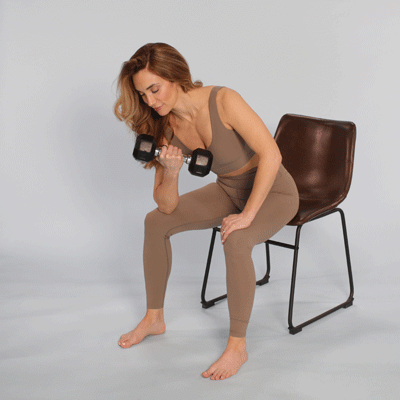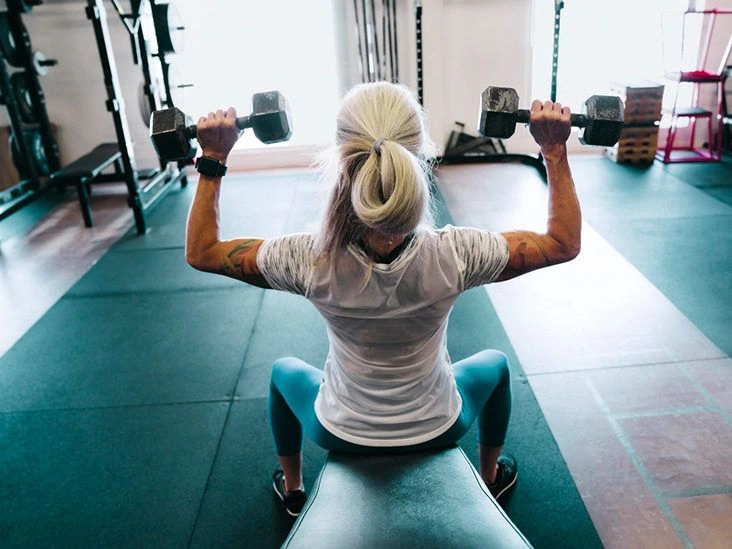Dumbbells offer a simple, versatile way to add resistance to exercises for the biceps, triceps, forearms, and shoulders. They come in many weight options and are suitable for use at home or in the gym.
Well-developed, toned arms do more than enhance appearance and self-esteem. Working your arm muscles also delivers important health advantages.
Improved arm and shoulder strength can lower your risk of injury, help your posture, increase muscle mass that supports bone health, and stabilize joints.
A consistent arm routine using a basic pair of dumbbells can produce the outcomes you’re aiming for.
Below, we’ll review the dumbbell moves that are most effective for building and toning your forearms, biceps, triceps, and shoulders.
How to get started
Dumbbells typically come in two varieties: fixed-weight and adjustable. Most gyms stock numerous pairs of fixed dumbbells across a range of weights.
If you exercise at home, adjustable dumbbells can be a smart purchase since you can add or remove weight plates to suit different moves.
Pick a weight that lets you perform each exercise with proper technique while maintaining tension in the targeted muscles.
Begin with two to three sets of 10 to 15 repetitions for each exercise listed here. When you can complete 15 reps of an exercise with ease, increase the weight.
About reps and sets
- What is a repetition? A repetition (rep) is one full movement of an exercise—for example, one dumbbell curl.
- What is a set? A set is a group of repetitions. For instance, 15 dumbbell curls count as one set.

Biceps exercises
Movements that involve throwing, pulling, or swinging rely heavily on the biceps. These muscles sit at the front of the upper arm between the shoulder and the forearm.
3. Bicep curls

The classic bicep curl can be performed standing or seated at the edge of a bench.
To perform this exercise:
- Hold a dumbbell in each hand with arms at your sides and palms facing forward.
- Inhale, then exhale as you slowly curl the weights up toward your shoulders.
- Concentrate on using your biceps to lift the weights. Avoid rocking, leaning forward, or arching your back. Keep your core engaged and spine neutral.
- Pause briefly at the top, then lower the dumbbells back to the starting position.
4. Concentration curls

A small 2014 study by the American Council on Exercise of people aged 18 to 24 found the concentration curl to be highly effective at isolating and strengthening the biceps.
To perform this exercise:
- Sit on a bench or chair with your legs spread and lean forward slightly.
- Pick up a dumbbell in your left hand and rest your elbow on the inside of your left thigh. This is the start position.
- With your palm facing up, slowly curl the dumbbell toward your shoulder.
- Pause, then lower the weight back to the start position in a controlled manner.
- After finishing a set with the left arm, repeat the same steps with the right arm.
Triceps exercises
The triceps sit on the back of the upper arm and are responsible for elbow extension and shoulder stabilization. Well-developed triceps assist with pushing, reaching, and throwing motions.
5. Triceps kickback

Triceps kickbacks are great for isolating, toning, and strengthening the triceps.
To perform this exercise:
- Stand holding a dumbbell in each hand with arms at your sides and palms facing each other.
- Bend your knees slightly and hinge at the hips, keeping your arms close to your sides.
- Bend at the elbows so the dumbbells sit just in front of your hips—this is the starting position.
- As you exhale, contract the triceps and straighten your arms to extend them behind you.
- Pause, then return your arms to the starting position.
6. Overhead extension

An overhead extension is performed with a single dumbbell held by both hands.
To perform this exercise:
- Sit or stand with a straight back and grip one dumbbell with both hands around the handle.
- Raise the dumbbell overhead to begin.
- Slowly bend your elbows, lowering the dumbbell behind your head.
- Then, slowly extend your elbows to lift the dumbbell back to the start.
Shoulder and arm exercises
The shoulder is one of the body’s most complex joints, offering a wide range of motion.
Strong shoulder muscles are essential because most arm actions involve the shoulders. They add joint stability, reduce the chance of arm injuries, and support overhead movements.
7. Lateral raise

Lateral raises target the shoulder muscles and also engage the triceps.
To perform this exercise:
- Stand or sit with a dumbbell in each hand at your sides.
- With palms facing your body and a slight bend in the elbows, lift the dumbbells out to the sides up to shoulder height so your arms form a T-shape.
- Slowly lower the dumbbells back to the starting position.
8. Dumbbell front raise

Front raises work the shoulders and also involve the chest and biceps to some extent.
To perform this exercise:
- Sit or stand holding a dumbbell in each hand.
- Bring your arms in front of you with palms facing your thighs.
- Keeping your arms straight, lift the dumbbells until your arms reach shoulder height and are parallel to the floor.
- Slowly lower the dumbbells back to the starting position.
9. Military press

The military press, or shoulder press, targets shoulder, arm, and chest muscles and can be done seated or standing.
To perform this exercise:
- Hold a dumbbell at about chin height above each shoulder with palms facing forward.
- Exhale as you press the dumbbells upward, extending the arms overhead without fully locking the elbows.
- Hold briefly at the top, then slowly lower the weights back to the starting position.
Chest and triceps exercise
10. Chest press

The chest press is a fundamental upper-body exercise that engages the pectorals (chest), triceps, and deltoids (shoulders).
To perform this exercise:
- Lie on the floor or on a bench with your feet flat on the ground.
- Hold a dumbbell in each hand with palms facing forward toward your knees. Bend your elbows so your upper arms are parallel to the floor and your forearms form a 90-degree angle with the floor.
- Inhale as you set the dumbbells just wider than chest width—this is the starting position.
- Exhale as you press the dumbbells upward, avoiding locking your elbows.
- Slowly lower the weights back to the starting position.
Safety tips
Follow these guidelines to exercise safely:
- Use correct technique and avoid weights that are too heavy to reduce injury risk.
- If you’re not confident in your form, train with a certified personal trainer until you can perform the movements safely on your own.
- For overhead moves like the military press, chest press, or overhead extension, consider having a spotter when weights become challenging.
- Warm up prior to lifting. Brisk walking, arm circles, swings, or pushups help increase blood flow and warm the muscles.
- Allow a day or two of rest between arm workouts to let muscles recover.
Frequently asked questions
Can you build arms with just dumbbells?
Yes. Dumbbells are a proven method to add resistance for arm work, promoting strength gains and muscle hypertrophy (size). Choosing the right load is important—the final rep in a set should feel very challenging.
Can 2 kg dumbbells tone arms?
Dumbbells weighing 2 kilograms (about 5 pounds) can provide sufficient resistance to tone some arm muscles but may be insufficient for all movements. They might be adequate for exercises like triceps kickbacks or lateral raises, but are likely too light for larger, stronger exercises such as the overhead press or chest press.
The bottom line
Working your arms and shoulders offers multiple benefits: increased strength, improved muscle tone and lean mass, reduced injury risk, better posture, bone protection, and joint stabilization.
For a well-rounded fitness regimen, alternate arm-focused workouts with exercises targeting the lower body and core, and include aerobic activity each week to support cardiovascular health.


















Leave a Reply
You must be logged in to post a comment.